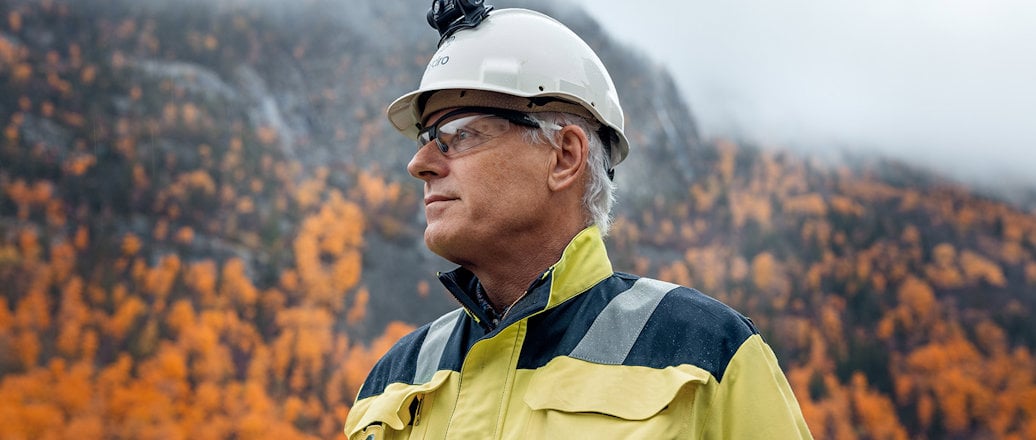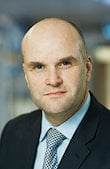- Weaker results in challenging and uncertain markets, firm mitigating actions in place
- Delivering on strategic growth agenda in Extrusions and recycling, capturing value from Alumetal
- Executing on decarbonization roadmap across the value chain, delivered first Hydro REDUXA 3.0 to Mercedes-Benz
- EU regulatory framework supporting strategy, disappointing Norwegian national budget
- Hydro Rein capital raise finalized, partnering with Macquarie Asset Management for renewables growth
Lower aluminium and alumina sales prices, lower Extrusions and recycling volumes, reduced CO2 compensation, and a provision for a multi-year social donation in Brazil, negatively impacted results, partly offset by lower raw material costs.
On October 15, a third party contractor was fatally injured while deconstructing an old transformer in Hydro’s joint venture, Qatalum, in Qatar. On October 18, a contractor passed away at Hydro’s Alunorte alumina refinery in Brazil while performing a maintenance operation.
“I am deeply saddened that two young men who came to work in our plants did not come home safe to their families. Our heartfelt condolences go to the family and the affected colleagues,” says President and CEO, Hilde Merete Aasheim.
In the third quarter of 2023, economic growth faced challenges due to rapid monetary tightening, pressuring household spending and business investments. Demand for primary aluminium continued to decline into the third quarter, while Chinese demand is stronger than expected on strong demand in the renewables and EV segments. Global demand has remained weak for residential building and construction, and industrial segments, while demand for automotive has been more stable. However, in North America, trailer and automotive build rates have slowed, and could be further impacted by the United Auto Workers (UAW) strike.
“Hydro is responding to declining markets with firm mitigating measures. Within Hydro Extrusions and recycling, we are using our production flexibility and adaption abilities to maneuver in weaker markets,” says Aasheim.
Hydro continues the strong focus on cash release and working capital reduction with a year-to-date release of more than NOK 4 billion. Hydro’s improvement program has progressed significantly during the quarter and commercial ambitions are ahead of the target for 2023. The strategic hedging program is further supporting margins, with 440,000 tonnes currently hedged at an LME of USD 2,500 per tonne in 2024, and 300,000 tonnes hedged at an LME of USD 2,400 per tonne in 2025.
The 2024 Norwegian national budget proposal, revealed on October 6, surprised with significant changes to industrial and power development conditions. The CO2 Compensation Scheme, designed to safeguard European industrial competitiveness, may see the CO2 price floor rise from 200 to 375 NOK per tonne, impacting Hydro negatively with NOK 1 billion annually. Additionally, a 35 percent resource rent tax on wind power profits is proposed for 2024. This tax could hinder investment in renewable capacity expansion. These changes are being negotiated and await parliamentary approval.
“We are surprised and disappointed the government has once again chosen to weaken the competitiveness of the industry by cutting the established CO2 compensation scheme. This is unfortunate and it undermines the predictability of Norwegian industrial policy,” says Aasheim.
On October 24, Hydro signed an agreement with Macquarie Asset Management who will acquire 49.9 percent of Hydro’s renewable energy company, Hydro Rein. This transaction marks an important milestone for the execution of Hydro’s strategic pillar of growing in renewable energy, while keeping this capital light. Through this partnership, Hydro and Macquarie will form a joint venture (JV) where Hydro will own 50.1 percent of the company. Macquarie intends to invest equity of USD 332 million to obtain a 49.9 percent ownership of Hydro Rein. The transaction values Hydro Rein on a debt free basis at USD 333 million, per June 30, 2023. Including the capital provided by Macquarie, no further equity injections from Hydro are planned for, and Hydro Rein has an ambition to be self-funded for growth.
“Despite market volatility and geopolitical turmoil, the long-term outlook for aluminium is promising. Toward 2030, Hydro expects significant growth for aluminium, driven by electric vehicles, energy effective buildings as well as aluminium in infrastructure to support the energy transition,” says Aasheim.
According to its 2025 strategy, Hydro continues to strengthen the position in low-carbon aluminium and to grow in attractive market segments. Hydro Extrusions has inaugurated three new presses in Suzhou, China, Trzcianka, Poland, and Nenzing, Austria. These new facilities strengthen the portfolio of cutting edge extrusion capacity aimed at industries like automotive, electric vehicles, and building and construction. The growth strategy of Hydro Extrusions is aimed at expanding with the market, particularly focusing on segments where Hydro has a competitive edge. The expansion of production capacity, in combination with ongoing sustainability efforts, enhances resilience and contributes to Extrusions NOK 8 billion EBITDA target.
Hydro aims to add 1 million tonnes of new recycling capacity to the portfolio by 2027, primarily in Europe and North America, to meet the growing demand for recycled aluminium. Hydro announced the opening of the HyForge casting line in Rackwitz on September 14, expanding capacity to supply the automotive industry with low-carbon recycled aluminium from post-consumer scrap. This investment directly responds to the automotive sector's increasing need for low-carbon, lightweight aluminium parts. Additionally, the greenfield recycling plant in Cassopolis, Michigan, is progressing as planned. Equipment is currently being commissioned and the first metal is expected to be produced by November. The plant is expected to be in full operation by the second quarter next year after a gradual ramp-up during the first quarter.
On July 7, the share purchase for the Polish recycler Alumetal S.A was settled, resulting in 275,000 additional tonnes of annual recycling capacity, a solid recycling position in Europe, as well as advanced sorting and casting capabilities. During the third quarter, a NOK 200 million investment was announced to modernize and expand the Alumetal recycling plant in Kęty, Poland, expanding the capacity with approximately 30,000 tonnes of foundry alloys for the automotive market. In addition to the Kęty investments, several synergy potentials are identified, with an identified potential EBITDA uplift ranging from EUR 10 to 15 million by 2027.
Hydro is determined to contribute to economic and social development in the communities where the company operates. The TerPaz program in the state of Pará, Brazil, where Hydro has made a commitment to contribute to build six peace houses, will nurture social inclusion and opportunities in cultural, educational, economic, and human rights areas. TerPaz is an important initiative to reduce lethal violent crimes, and a commitment to donate approximately NOK 500 million for the next three years is recognized during the third quarter to support this agenda.
For shareholders, Hydro initiated a new share buyback program on September 22, 2023. The program covers a purchase of up to 100,000,000 shares with a maximum value of NOK 2,000 million, inclusive of the proportional redemption of shares owned by the Norwegian State. As of October 17, 2023, Hydro has purchased 3,719,484 own shares and owns a total of 18,816,362 shares, corresponding to 0.92 percent of Hydro’s share capital.
Results and market development
Third quarter 2023 adjusted EBITDA for Bauxite & Alumina decreased compared to the third quarter of last year. Lower alumina sales prices, currency, and the TerPaz peace house expenses were partly offset by lower raw material prices. The average Platts alumina index (PAX) traded in a narrow range between USD 325 per mt and USD 345 per mt throughout the quarter, ending the quarter at USD 338 per mt. In China, alumina prices rose throughout the quarter driven by smelter capacity restarts in the Yunnan province and lower alumina production due to domestic bauxite shortages. Compared to the third quarter of 2022, the average Platts alumina index was stable.
Adjusted EBITDA for Aluminium Metal decreased in the third quarter of 2023 compared to the third quarter of 2022, mainly due to lower all-in metal prices, reduced CO2 compensation, and lower contribution from power sales, partly offset by positive currency effects, and reduced alumina and carbon cost. Global primary aluminium consumption was up 2 percent compared to the third quarter of 2022, driven by a 3 percent increase in China. The three-month aluminium price increased throughout the third quarter of 2023, starting the quarter at USD 2,158 per mt and ending at USD 2,347 per mt.
Adjusted EBITDA for Metal Markets increased in the third quarter compared to the same quarter last year. Strong results from sourcing and trading activities were partly offset by lower results from recyclers, and negative inventory valuation and currency effects.
Extrusions adjusted EBITDA for the third quarter of 2023 is slightly lower than the same quarter last year, driven by lower sales volumes, and higher fixed and variable costs, positively offset by increased sales margin and currency effects. European demand for extrusions in the third quarter of 2023 is estimated to have decreased 20 percent compared to the same quarter last year and 21 percent compared to the second quarter of 2023, driven by seasonality. Demand for residential building, and construction and industrial segments has remained weak in the third quarter, while demand for automotive has been more stable, supported by increased share of electric vehicle registrations over total auto registrations. The solar segment has been negatively impacted by supply chain bottlenecks and lower installations. North American extrusion demand is estimated to have decreased 17 percent during the third quarter of 2023 compared to the same quarter last year and 6 percent compared to the second quarter of 2023. Demand continues to be weak in residential building, and construction and industrial sectors. In the transport segment, lower trailer build rates have started to negatively impact demand. Automotive build rates have also recently slowed and could be impacted by the UAW strike against the three unionized US automakers.
Adjusted EBITDA for Hydro Energy in the third quarter is higher than the same period last year. Higher production and lower recognized tax cost in Hydro’s equity accounted investment company Lyse Kraft DA, as a result of the legal restructuring in 2022, were partly offset by lower gain on price area differences, lower prices, and loss on a 12-month internal fixed price purchase contract from Aluminium Metal from early October 2022. Nordic power prices in the third quarter were on average lower than the previous quarter and significantly lower than in the same quarter last year. The lower prices can primarily be explained by an improved Nordic hydrological balance and declining fuel prices. Price area differences between the south and north of the Nordic market region declined somewhat from the previous quarter and were significantly lower than the same quarter last year.
Other key financials
Compared to the second quarter, Hydro’s adjusted EBITDA decreased from NOK 7,098 million to NOK 3,899 million in the third quarter 2023. Lower realized aluminium and alumina prices combined with lower Extrusions and recycling volumes were partly offset by lower raw material costs.
Net loss from continuing operations amounted to NOK 625 million in the third quarter of 2023. In addition to the factors described above, net income from continuing operations included a NOK 2,000 million unrealized derivative loss on LME related contracts, a net foreign exchange gain of NOK 214 million, and a NOK 110 million loss from unrealized derivative power and raw material contracts.
Hydro’s net debt increased from NOK 11.3 billion to NOK 13.8 billion during the third quarter of 2023. The net debt increase was mainly driven by NOK 7.5 billion investments, partly offset by EBITDA contribution and net operating capital release.
Adjusted net debt increased from NOK 15.9 billion to NOK 20.4 billion, primarily due to the increase in net debt of NOK 2.5 billion, and an increase in collateral for hedging contracts and investments commitments.
Reported earnings before financial items and tax (EBIT), and net income include effects that are disclosed in the quarterly report. Adjustments to EBITDA, EBIT and net income (loss) are defined and described as part of the alternative performance measures (APM) section in the quarterly report.
The information was submitted for publication from Hydro Investor Relations and the contact persons set out above. Certain statements included in this announcement contain forward-looking information, including, without limitation, information relating to (a) forecasts, projections and estimates, (b) statements of Hydro management concerning plans, objectives and strategies, such as planned expansions, investments, divestments, curtailments or other projects, (c) targeted production volumes and costs, capacities or rates, start-up costs, cost reductions and profit objectives, (d) various expectations about future developments in Hydro's markets, particularly prices, supply and demand and competition, (e) results of operations, (f) margins, (g) growth rates, (h) risk management, and (i) qualified statements such as "expected", "scheduled", "targeted", "planned", "proposed", "intended" or similar. Although we believe that the expectations reflected in such forward-looking statements are reasonable, these forward-looking statements are based on a number of assumptions and forecasts that, by their nature, involve risk and uncertainty.
Various factors could cause our actual results to differ materially from those projected in a forward-looking statement or affect the extent to which a particular projection is realized. Factors that could cause these differences include, but are not limited to: our continued ability to reposition and restructure our upstream and downstream businesses; changes in availability and cost of energy and raw materials; global supply and demand for aluminium and aluminium products; world economic growth, including rates of inflation and industrial production; changes in the relative value of currencies and the value of commodity contracts; trends in Hydro's key markets and competition; and legislative, regulatory and political factors. No assurance can be given that such expectations will prove to have been correct. Except where required by law, Hydro disclaims any obligation to update or revise any forward-looking statements, whether as a result of new information, future events or otherwise. This information is considered to be inside information pursuant to the EU Market Abuse Regulation and is subject to the disclosure requirements pursuant to Section 5-12 the Norwegian Securities Trading Act.
Publicado: 24 de octubre de 2023









